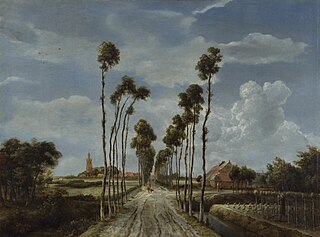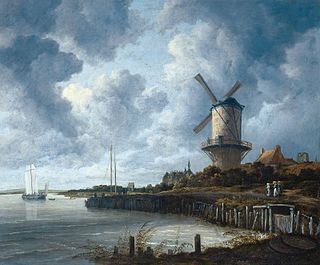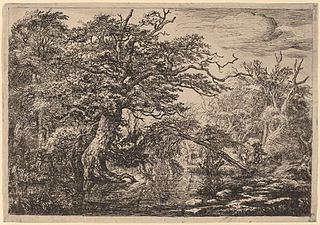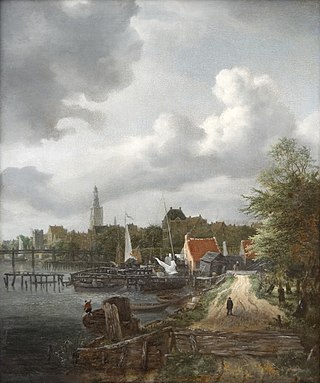
Meindert Lubbertszoon Hobbema was a Dutch Golden Age painter of landscapes, specializing in views of woodland, although his most famous painting, The Avenue at Middelharnis, shows a different type of scene.

Jacob Isaackszoon van Ruisdael was a Dutch painter, draughtsman, and etcher. He is generally considered the pre-eminent landscape painter of the Dutch Golden Age, a period of great wealth and cultural achievement when Dutch painting became highly popular.

The Jewish Cemetery is an oil-on-canvas painting by the Dutch landscape painter Jacob van Ruisdael, now at the Detroit Institute of Arts. While growing up in Haarlem, his father, Isaak van Ruisdael, and uncle Salomon van Ruisdael taught him painting. Jacob van Ruisdael painted an allegorical painting depicting hope and death in The Jewish Cemetery. Located on Amsterdam's outskirts, it is a prominent resting place for Amsterdam's large Jewish Portuguese community. These tomb monuments commemorate the leaders of the newly arrived Portuguese-Jewish community. The central elements of the painting, however, are different from how Ouderkerk appears to achieve the painting's compositional and allegorical intent. This painting is twice as large as the typical landscape painting from the 17th century. After being cataloged in England in 1835, the artwork, The Jewish Cemetery, disappeared. The Detroit Institution of Art acquired the painting in 1920 after rediscovering it in London.

Pieter Biesboer, is a Dutch art historian and prolific writer on 17th-century Dutch art. His specialty is art from Haarlem.

The Windmill of Wijk bij Duurstede is an oil-on-canvas painting by the Dutch painter Jacob van Ruisdael. It is an example of Dutch Golden Age painting and is now in the collection of the Amsterdam Museum, on loan to the Rijksmuseum.

Landscape with a Cottage and Trees (1646) is an oil-on-panel painting by the Dutch Golden Age painter Jacob van Ruisdael. It is in the collection of the Kunsthalle in Hamburg.

Wooded Dunes, also known as Dune Landscape, Peasant Cottage in a Landscape, Wooded Dunes and Cottage in a Grove is a 1646 oil-on-panel painting by the Dutch Golden Age painter Jacob van Ruisdael. It is in the collection of the Hermitage Museum in St. Petersburg.

Forest Marsh with Travellers on a Bank (1640s-1650s), also known as The Travellers, is an etching by the Dutch Golden Age artist Jacob van Ruisdael. A few copies are known, including those in the collections of the British Museum, Metropolitan Museum of Art in New York, the Rijksprentenkabinet of the Rijksmuseum Amsterdam, and Museum Boymans-van Beuningen in Rotterdam.

Grainfield at the Edge of a Wood, also known as The Cornfield, is a 1648 etching by the Dutch Golden Age artist Jacob van Ruisdael. There are five versions known about the etching. The first state is at the British Museum in London. The second state, in which a few lines in the sky have been added, is at the Rijksmuseum in Amsterdam. On the later states "JvRuysdael" has been added by another hand than Jacob's.

Two Water Mills with an Open Sluice, also known as Two Watermills and an Open Sluice, Two Undershot Water Mills with an Open Sluice is a 1653 painting by the Dutch Golden Age painter Jacob van Ruisdael. It is in the collection of the Getty Museum in Los Angeles.

View of the Binnenamstel at Amsterdam is a 17th-century oil on canvas painting by the Dutch Golden Age painter Jacob van Ruisdael. It is in the collection of the Museum of Fine Arts in Budapest.

Panoramic view of the Amstel looking toward Amsterdam is a 17th-century oil on canvas painting by the Dutch Golden Age painter Jacob van Ruisdael. It is in the collection of the Fitzwilliam Museum in Cambridge.

Evening Landscape: A Windmill by a Stream is a 17th-century oil on canvas painting by the Dutch Golden Age painter Jacob van Ruisdael. It is in the collection of Queen Elizabeth II, on display at the Queen's Gallery at Buckingham Palace. It was acquired by King George IV in 1810.

A Thatch-Roofed House with a Water Mill, also known as Water Mill near a Farm, is a 17th-century oil on panel painting by the Dutch Golden Age painter Jacob van Ruisdael. It is in the collection of the Museum Boijmans Van Beuningen in Rotterdam.

View of the Dam and Damrak at Amsterdam, also known as Quay at Amsterdam, is a 17th-century oil on canvas painting by the Dutch Golden Age painter Jacob van Ruisdael. It is since 1910 in the Frick Collection in New York. It is currently not on view.

View of the Dam and Damrak at Amsterdam is a 17th-century oil on canvas painting by the Dutch Golden Age painter Jacob van Ruisdael. It is in the collection of the Mauritshuis in the Hague. It gives a bird's eye view of the crowd watching the parade of the civic guard on the Dam Square, the main square of Amsterdam.
Jakob Rosenberg was an art historian, museum curator, and educator who is noted particularly for published work on Rembrandt. He was active in Germany until his 1937 emigration to the United States, where he joined the faculty of Harvard University. In addition to his professorship he was the curator of prints at the Fogg Museum. Rosenberg retired in 1964, but continued his scholarly activities until his 1980 death in Cambridge, Massachusetts.

Landscape with a Windmill is an oil-on-panel painting executed by the Dutch artist Jacob van Ruisdael in 1646, early in his career. It is now in the Cleveland Museum of Art in Ohio. It had initially been loaned to them by the Mr and Mrs William H. Marlatt fund, who had bought it in 1967 from Kunsthandlung F. Kleinberger & Co, a New York art dealer, who had in turn bought it at the auction of the Cook collection at Christie's in London on 25 November 1966.
















